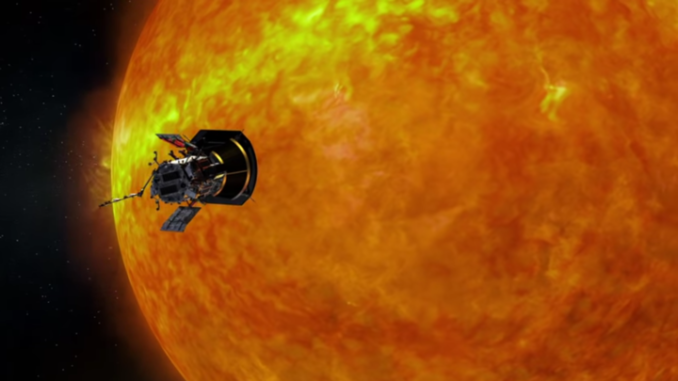
Sixty years ago, we knew almost nothing about ‘outer space’, as anything beyond Earth’s atmosphere was then colloquially known. It was the late 1950s, and people were obsessed with travel to the moon and planets, flying saucers, alien visitors from the skies, and space generally. The interest was reflected in toys, movies, radio, and TV shows. Even the cars were styled like rocket ships, with big tail fins and tail lights representing rocket engine exhaust nozzles.
In 1958, Eugene Parker, a young physicist at the University of Chicago, proposed a crazy theory about space that he’d been developing. Parker had been mulling over theories about the Sun that other scientists before him had postulated.
In 1859, astronomer Richard Carrington observed an event on the surface of the Sun that would later be known as a solar flare. The next day, a ‘solar storm’, or geomagnetic storm took place in Earth’s magnetosphere, wreaking havoc with the telegraph system, causing fires and giving electrical shocks to telegraph operators. Carrington believed there was a relationship between the solar flare and the solar storm, and the episode became known as the Carrington Event. This was the first clue that something in addition to light moved outward from the Sun. In the case of the Carrington Event and other instances like it, that something was what we now know as a coronal mass ejection (CME).
In the 1930s, theories were developed about the Sun’s corona, which astronomers had long before discovered while studying total eclipses. The corona extends millions of miles outward from the surface of the Sun, which has a temperature of approximately 5,800° Kelvin (about 5,500° Celsius or 9,900° Fahrenheit). Those theories predicted the temperature of the corona would be around one million degrees Celsius (about 1.8 million degrees Fahrenheit). This was later confirmed with an instrument called a spectroscope.
In the 1950s, German astronomer Ludwig Biermann noted that the tail of comets always point directly away from the Sun: one more clue that something was traveling away from the Sun in all directions.
Which brings us back to 1958 and Eugene Parker, who put it all together. Mathematically, he showed that if the corona was one million degrees Celsius, it would still be very hot at great distances from the Sun (in part because it’s an excellent heat conductor). Because the force of gravity decreases with distance, the high energy particles of the outer corona (that which is farthest from the Sun) would escape the Sun’s gravitational pull and attain high velocity. Parker dubbed this movement of particles, “solar wind”.
Parker wrote a paper explaining his theory, including mathematical computations, and submitted it to the Astrophysical Journal. At that time, most scientists thought space to be an empty vacuum. The idea that there could be ‘space weather’ with solar wind, was a very radical idea which many felt deserved ridicule. Two peer reviewers for the Astrophysical Journal rejected the paper outright. One of them called Parker’s theory, “utter nonsense”. The editor, astrophysicist Subrahmanyan Chandrasekhar (already a giant in the field and a future Nobel laureate) didn’t believe it either but, finding no errors in Parker’s computations, decided to publish it anyway. Parker’s theory was heavily criticized, but he didn’t have to wait long for requital.
The existence of the solar wind was confirmed in 1962 by the Mariner 2 spacecraft’s mission to Venus. [Soviet spacecraft Luna 1, Luna 2, and Luna 3 (all launched in 1959) confirmed the solar wind first, but at this time the Night Owl can neither confirm nor deny that the Soviets shared that data with the West.]
The solar wind magnetically blankets the solar system, protecting life on Earth from even higher-energy particles coming from elsewhere in the galaxy. But it also affects the sophisticated satellite communications we have today. So understanding the precise structure and dynamics and evolution of the solar wind is crucial for civilization as a whole.
Prof. Angela Olinto, Dean of the Physical Sciences at UChicago
Since then, Parker has made several other enormous contributions to astrophysics. To honor Dr. Parker, in 2017, shortly before his 90th birthday, NASA named the Parker Solar Probe in his honor, the first spacecraft to be named after a living person.
Retired since 1995, Professor Emeritus Parker was in attendance on August 12, 2018, to watch the launch of the Parker Solar Probe from Cape Canaveral, Florida, which is now on a seven year mission to the nearest star, our Sun.
Why Dr. Parker? Because this mission is there because of him. He’s really the father of this whole physics branch. Heliophysics is the study of the sun and what it does to the solar system, and the way it does that is the solar wind. Gene was the one who predicted it and profoundly changed the way we thought about how our star worked.
Nicola Fox, Parker Solar Probe project scientist, Johns Hopkins University in Maryland
Question of the night: Does sunshine on your shoulder make you happy? (Hat tip to John Denver).

1 Trackback / Pingback
Comments are closed.